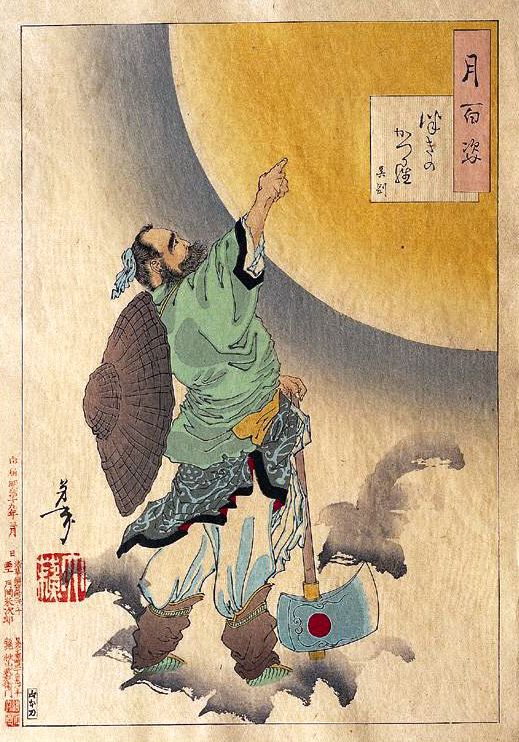Wu Gang
 Wu Gang (|s=|p=Wú Gāng}}), formerly romanized as Wu Kang and also known as Wu Zhi in some sources, is a figure in traditional Chinese folklore and religion. He is known for endlessly cutting down a self-healing osmanthus tree on the Moon,}}), which originally referred to both the sweet osmanthus (now }}, "''guì'' flower"), a species of olive, and the cassia (now }}, "meat ''guì''"). Because of the latter's greater importance in modern international trade, it is often encountered in English translations although the sweet-smelling osmanthus is the one meant. See, for instance, Wolfram, who consistently translates ''guì'' (}}) as "cassia" while in fact describing and giving the scientific name for sweet osmanthus.
Wu Gang (|s=|p=Wú Gāng}}), formerly romanized as Wu Kang and also known as Wu Zhi in some sources, is a figure in traditional Chinese folklore and religion. He is known for endlessly cutting down a self-healing osmanthus tree on the Moon,}}), which originally referred to both the sweet osmanthus (now }}, "''guì'' flower"), a species of olive, and the cassia (now }}, "meat ''guì''"). Because of the latter's greater importance in modern international trade, it is often encountered in English translations although the sweet-smelling osmanthus is the one meant. See, for instance, Wolfram, who consistently translates ''guì'' (}}) as "cassia" while in fact describing and giving the scientific name for sweet osmanthus.In Chinese, meanwhile, the ''chengyu'' "pluck osmanthus in the Toad Palace" (}}, ''chángōng-zhéguì'') associating the lunar tree with passing the imperial examinations eventually led to the association of the tree with the true laurel, which bears similar associations in European cultures from its use in Greece and Rome. It is now known in Chinese as the ''yuèguì'' (}}) or "Moon ''guì''" and connected with the earlier myths.}} a divine punishment which has led to his description as the Chinese Sisyphus. In modern Chinese, the ''chengyu'' "Wu Gang chopping the tree" (}}; ''wúgāng-fáguì'') is used to describe any endless toil. The specific reason for his situation has varied in the sources, but Wu Gang's story dates back to at least the Tang dynasty. Provided by Wikipedia
-
1
-
2
-
3
-
4
-
5
-
6
-
7
-
8
-
9
-
10
-
11
-
12
-
13
-
14
-
15
-
16
-
17
-
18
-
19
-
20
